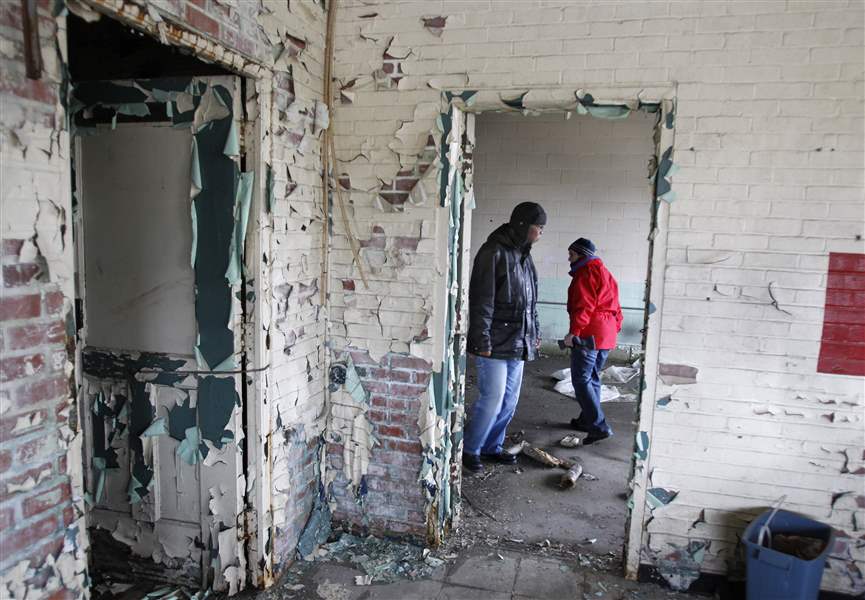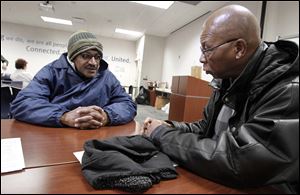
IN SEARCH OF THE UNSHELTERED
Toledo agencies conduct 24-hour homeless count
1/26/2012
John Whitlow, left, and Lori Berry, outreach technicians with Neighborhood Properties, search for homeless people in a vacant building on Front Street in East Toledo.
The Blade/Dave Zapotosky
Buy This Image

John Whitlow, left, and Lori Berry, outreach technicians with Neighborhood Properties, search for homeless people in a vacant building on Front Street in East Toledo.
From a wooded area in International Park, to abandoned houses, to parked cars near an I-75 exit ramp, John Whitlow knows where homeless people can be found.
Mr. Whitlow, an outreach worker with Neighborhood Properties Inc., hit the streets Wednesday in search of the un-sheltered as part of an annual count of the area’s homeless population. The 24-hour count was conducted by the Toledo Area Alliance to End Homelessness, the Toledo Lucas County Homelessness Board, and dozens of volunteers.
The U.S. Department of Housing and Urban Development mandates a count of all homeless individuals to give a snapshot of the local homeless picture every year. In recent years, the total number of homeless individuals counted in Toledo has been about 900 to 1,000 people annually, said Donna Perras, executive director of Harbor House, a transitional house for homeless women.
Mr. Whitlow’s day began early, about 5 a.m., so he and co-worker Lori Berry could find as many people as possible, administer a survey, and give out information about housing, as well as assistance like blankets and hygiene kits.
While the annual count was Wednesday, Mr. Whitlow spends most of his days in search of the homeless, then trying to line up shelter, mental health services and other supports. (He estimates about 85 percent of the people he encounters have some sort of mental health problem.)
“I have been homeless. And a mental health patient. So, I didn’t learn this from a book. I lived this,” Mr. Whitlow explains.
A man in dirty sweatpants and carrying several shopping bags calls and greets him, “Hey, Mr. Whitlow!” mid-morning on Wednesday, outside the downtown office of United Way.
After a quick stop at United Way, Mr. Whitlow and Ms. Berry head to International Park in East Toledo. In a wooded area near the S.S. Col. James M. Schoonmaker museum ship, they find two campsites, a tent, clothes strewn about and an empty cooler. No one is here at the moment; Mr. Whitlow suspects the residents are in a nearby fast-food restaurant.
Next stop: the old Toledo Edison plant site on Front Street. At a small building on the property, again there are signs of habitation — coffee cups scattered, cushions arranged in a bed and a needle on the ground — but no people.
The count can’t capture everyone; about 20 percent of those without shelter are probably missed, estimates Debbie Conklin, executive director of the homelessness board. Getting an accurate count is essential, Ms. Conklin said.
“The information is critical,” she said. “It is shared with HUD and our other major funders. It is looked at very closely. Is there an increase? Are the characteristics different?”
The count is linked to funding from HUD for area agencies.
The United Way of Greater Toledo says 211 requests for shelter assistance have increased steadily from 1,690 in 2009 to 2,220 last year.
A recent report from The National Alliance to End Homelessness found nationally there were 636,017 homeless people in 2011. It also reported that while homelessness from 2009 to 2011 declined slightly nationally, it increased in Ohio, from 12,700 to 13,030 people. Additionally, the report noted the “doubled up” population — those who live with friends, family or others for economic reasons and are not considered “homeless” by HUD — increased by 13 percent nationally from 6 million in 2009 to 6.8 million in 2010 and has increased by more than 50 percent from 2005 to 2010, according to the report, The State of Homelessness in America 2012.

Clive Nicholson of Toledo, left, who is homeless, talks with John Whitlow at the United Way building Wednesday as part of the annual count of the area's homeless population mandated by HUD.
One of these “doubled up” individuals is Dawn Skowron, 53, who is living in Toledo with a friend, but said she will likely move to a shelter soon. She was at the United Way Wednesday; though she couldn’t be tallied in the count, she was able to receive information about available assistance.
“I had no idea there was so much stuff out here for help,” she said.
About lunchtime, Mr. Whitlow and Ms. Berry head to St. Paul’s Community Center, an emergency shelter on 13th Street. Workers will tally everyone here for lunch who is willing to participate in this year’s count. Questions asked include demographic information as well as where the person slept last night.
Clive Nicholson, 43, is taking advantage of the shelter’s winter crisis center. He estimates this is his fourth time being homeless in about the last 12 years, because of mental health and chronic substance abuse problems.
“I know that there are resources [available], but once I get in that using environment, I don’t know where to turn,” he said.
After stopping at St. Paul’s, Mr. Whitlow and Ms. Berry head back to the streets. They go to a large vacant building on the East side, near Main and 6th streets. Just inside the broken down plywood at a back entrance is an old mattress and ripped couch.
Mulling over the plight of many of the area’s homeless residents, he emphasizes it is critical for the community to support services that help people find housing and support those in need of mental health counseling or rehab.
“As a community, we all need to help out,” he said before he and Ms. Berry drive off to continue their search.
Contact Kate Giammarise at: kgiammarise@theblade.com or 419-724-6091.